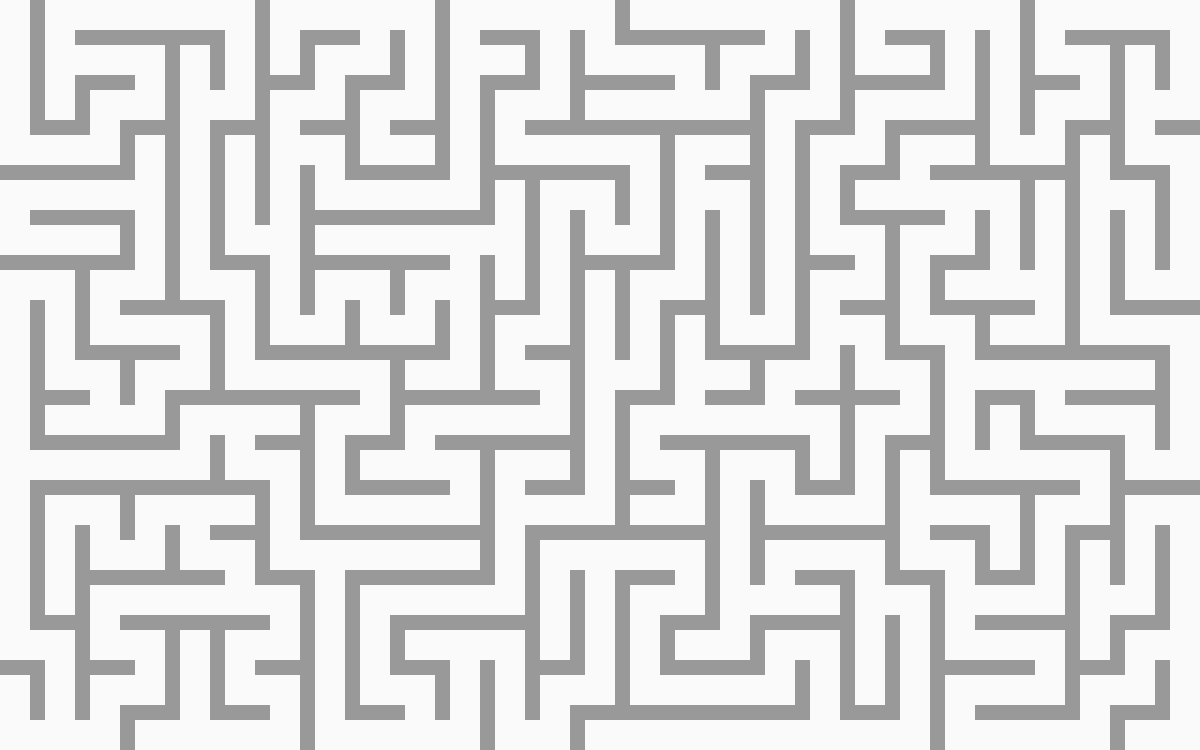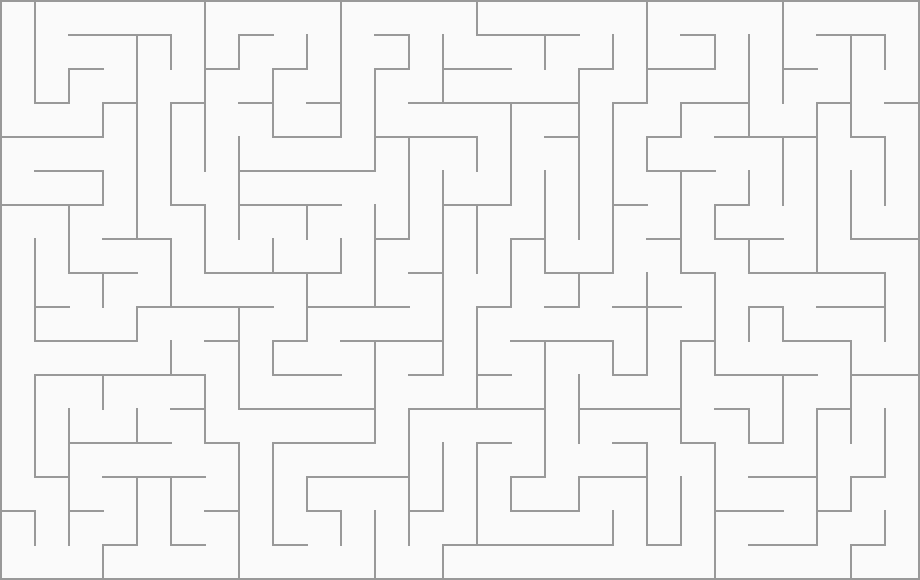迷路の壁を薄く表示する方法
コード
require "matrix"
require "pathname"
require "active_support/core_ext/class/attribute"
require "active_support/core_ext/module/delegation"
class V < Vector
class << self
def l
self[-1, 0]
end
def r
self[1, 0]
end
def u
self[0, -1]
end
def d
self[0, 1]
end
def around
[
u,
r,
d,
l,
]
end
end
def initialize(...)
super
freeze
end
def x
self[0]
end
def y
self[1]
end
def length_squared
x**2 + y**2
end
def distance_squared_to(other)
(other - self).length_squared
end
def distance_to(other)
Math.sqrt(distance_squared_to(other))
end
def to_s
"(#{x},#{y})"
end
def inspect
to_s
end
end
Rect = Data.define(:w, :h) do
def self.from_w_h(...)
new(...)
end
def cover?(v)
(0...w).cover?(v.x) && (0...h).cover?(v.y)
end
def w_h
[w, h]
end
end
class Base
class_attribute :logic_name, default: "?"
class_attribute :seed, default: 0
attr_accessor :rect
attr_accessor :field
class << self
def build(...)
new(...).tap do |e|
e.build
end
end
end
def initialize(rect: Rect.from_w_h(25, 7), seed: self.class.seed, **options)
@rect = rect
@options = options
@field = {}
@nodes_hash = {}
@counts = Hash.new(0)
if seed
srand(seed)
end
end
def build
fill(:wall)
non_recursive_dig(start)
end
def to_s(...)
border_type = " ##"
border_line = ([border_type] * (@rect.w + 2)).join
s = [
border_line,
@rect.h.times.collect { |y|
[
border_type,
@rect.w.times.collect { |x| "%3s" % cell_as_string(V[x, y], ...) },
border_type,
].join
},
border_line,
] * "\n"
s.gsub(/^\s+/, "")
end
def to_s_start_to_goal
to_s do |v|
if start_to_goal
if start_to_goal.include?(v)
"o"
end
end
end
end
def output(file)
Pathname(file).write(to_s)
end
def walk_info
{
"名前" => logic_name,
"歩数" => @counts[:walk],
"重複" => @counts[:uturn], # 同じ場所を歩いた歩数
}
end
private
def recursive_dig(v0)
route_set(v0)
V.around.shuffle.each do |e|
v1 = v0 + e
v2 = v1 + e
if @field[v2] == :wall
route_set(v1)
dig(v2)
end
end
end
def non_recursive_dig(v0)
stack = [v0]
until stack.empty?
v0 = stack.last
if @field[v0] == :wall
route_set(v0)
end
v = V.around.shuffle.find { |v| @field[v0 + v + v] == :wall }
unless v
stack.pop
next
end
route_set(v0 + v)
stack.push(v0 + v + v)
end
end
def fill(value)
cell_each do |v|
@field[v] = value
end
end
def cell_each(&block)
@rect.h.times do |y|
@rect.w.times do |x|
yield V[x, y]
end
end
end
def odd_cells
@odd_cells ||= [].tap do |av|
cell_each do |v|
if v.x.odd? && v.y.odd?
av << v
end
end
end
end
def even_cells
@even_cells ||= [].tap do |av|
cell_each do |v|
if v.x.even? && v.y.even?
av << v
end
end
end
end
def invalid?(v)
!valid?(v)
end
def valid?(v)
@rect.cover?(v)
end
def wall_set(v)
@field[v] == :route or raise ArgumentError, v.inspect
set(v, :wall)
end
def route_set(v)
@field[v] == :wall or raise ArgumentError, v.inspect
set(v, :route)
end
def top_left
V[0, 0]
end
def start
V[0, 0]
end
def goal
V[@rect.w.pred, @rect.h.pred]
end
def assert_start_and_goal_is_route
@field[start] == :route or raise
@field[goal] == :route or raise
end
def assert_inside_field(v)
valid?(v) or raise ArgumentError, v.inspect
end
def set(v, value)
assert_inside_field(v)
@field[v] = value
end
def walked_at(v, node)
assert_inside_field(v)
if @nodes_hash[v]
@counts[:uturn] += 1
end
@nodes_hash[v] = node
@counts[:walk] += 1
end
def cell_as_string(v, **options, &block)
if block
if s = block.call(v, options)
return s
end
end
case
when @field[v] == :wall
"XX"
when f = @nodes_hash[v]
case
when f.respond_to?(:to_footprint)
f.to_footprint(**options)
when f.respond_to?(:to_i)
f.to_i % 1000
else
"."
end
when v == start
"S"
when v == goal
"G"
when @field[v] == :route
""
else
raise v.inspect
end
end
def start_to_goal
@start_to_goal ||= yield_self do
if node = @nodes_hash[goal]
node.self_and_ancestors.reverse.collect(&:v)
end
end
end
end
class Node
attr_accessor :v
attr_accessor :parent
attr_accessor :path_cost
def initialize(v:, parent: nil)
@v = v
@parent = parent
@path_cost = 0
if @parent
@path_cost = @parent.path_cost.next
end
end
def total_cost
@path_cost
end
def to_footprint(**options)
total_cost
end
def self_and_ancestors
[self] + (parent ? parent.self_and_ancestors : [])
end
end
if true
require "rmagick"
include Magick
class ImageFormatter
delegate :rect, :field, to: :@base
def initialize(base, **options)
@base = base
@options = {
:route => 32,
:wall => 32,
:padding => nil,
:route_color => "hsl(0,0%,98%)",
:wall_color => "hsl(0,0%,60%)",
:frame_color => "hsl(0,0%,60%)",
}.merge(options)
end
def write
canvas.write(@options[:path])
end
private
def canvas
bg_layer.composite(fg_layer, *padding.w_h, OverCompositeOp)
end
def bg_layer
Image.new(*bg_layer_rect.w_h) do |e|
e.background_color = @options[:frame_color]
end
end
def fg_layer
layer = Image.new(*fg_layer_rect.w_h) do |e|
e.background_color = @options[:route_color]
end
wall_draw(layer)
layer
end
def wall_draw(layer)
cy = 0
rect.h.times do |y|
if y.odd?
h = wall.h
else
h = route.h
end
cx = 0
rect.w.times do |x|
if x.odd?
w = wall.w
else
w = route.w
end
v = V[x, y]
if field[v] == :wall
g = Draw.new
g.fill(@options[:wall_color])
g.rectangle(cx, cy, cx + w - 1, cy + h - 1)
g.draw(layer)
end
cx += w
end
cy += h
end
end
def fg_layer_rect
@fg_layer_rect ||= yield_self do
Rect.from_w_h(*[
(rect.w / 2 * wall.w) + ((rect.w / 2 + 1) * route.w),
(rect.h / 2 * wall.h) + ((rect.h / 2 + 1) * route.h),
])
end
end
def bg_layer_rect
@bg_layer_rect ||= Rect.from_w_h(*[
fg_layer_rect.w + padding.w * 2,
fg_layer_rect.h + padding.h * 2,
])
end
def route
@route ||= Rect.from_w_h(@options[:route], @options[:route])
end
def wall
@wall ||= Rect.from_w_h(@options[:wall], @options[:wall])
end
def padding
@padding ||= yield_self do
v = @options[:padding] || @options[:wall]
Rect.from_w_h(v, v)
end
end
end
Base.class_eval do
def write(path, **options)
options = { path: path }.merge(options)
ImageFormatter.new(self, **options).write
end
end
end
if $0 == __FILE__
require "test/unit"
class TestMain < Test::Unit::TestCase
test "works" do
object = Base.new(seed: nil)
object.build
object.to_s
end
test "works" do
10.times do |w|
10.times do |h|
object = Base.new(rect: Rect.from_w_h(w, h), seed: nil)
object.build
object.to_s
end
end
end
end
end
迷路が暑苦しい問題
迷路の通路と壁は内部では印の違いでしかないため単純に表示すると次のようになる。

これはこれでいいのだけどなんとも暑苦しい。そこでまず考えるのが壁の四角形だけ小さく表示してみるということだが、そうすれば壁と壁が接触しなくなり、迷路ではなくなってしまう。どうすればいいだろうか。
奇数番目だけ細くする
行と列でそれぞれ奇数のときに細くするだけで整合性のとれた細い壁ができる。なお、見かけではわからないが通路も奇数番目は細くなっている。擬似コードで書けば次のようになる。
cy = 0
行数.times do |y|
if y.odd?
h = 壁の縦幅
else
h = 通路の縦幅
end
cx = 0
列数.times do |x|
if x.odd?
w = 壁の横幅
else
w = 通路の横幅
end
if field[x, y] == 壁
# (cx, cy) から (cx + w - 1, cy + h - 1) の四角形(壁)を描画する
end
cx += w
end
cy += h
end
そうして壁を通路の半分にしたものがこれ。

さらに半分にする。

最終的に 2px にして外周にも 2px の壁を入れてすっきりしたものを完成とする。

画像の縦横幅を事前に求めるには?
上の画像は RMagick で出力したのだけど、コンソールに垂れ流すのとは異なり、レイヤーを事前に用意しないといけない。このときのレイヤーの縦横幅を求める部分が少し難しかった。が、次のように考えれば答えが出た。
仮に列数を 5 とした場合、通路は 0, 2, 4 の 3 列分あり、壁は 1 と 3 の 2 列分ある。つまり、
横の壁数 = 5列 / 2 = 2列分
横の通路数 = 5列 / 2 + 1 = 3列分
となる。これに壁と通路のピクセル数を掛けて足せばレイヤーの横幅が出る。仮に壁が 1px で通路が 10px とすれば次のようになる。
壁 = 2列分 * 1px = 2px
通路 = 3列分 * 10px = 30px
合計 = 2px + 30px = 32px
高さも同様にすれば求まる。
まとめると
レイヤー横幅 = (列数 / 2 * 壁の横幅) + ((列数 / 2 + 1) * 通路の横幅)
レイヤー縦幅 = (行数 / 2 * 壁の高さ) + ((行数 / 2 + 1) * 通路の高さ)
となる。
枠も必要なら
最終的に外周の壁に見えるフレーム(背景レイヤーと呼ぶことにする)も用意するなら
横幅 = 迷路レイヤー横幅 + padding * 2
縦幅 = 迷路レイヤー縦幅 + padding * 2
となる。
今回は、まず外枠を無視した迷路のレイヤーを作り、次に壁と同じ色で padding 分、大きくした背景レイヤーを用意し、背景レイヤーの (padding, padding) に迷路レイヤーを配置するという方法をとった。
Discussion